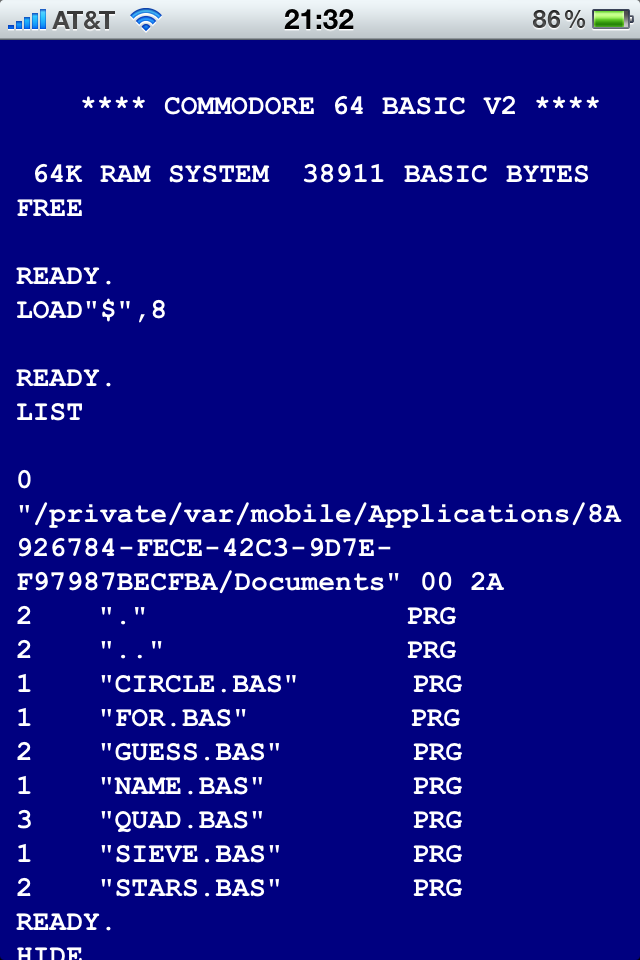Name that Ware
Standalone Commodore BASIC on the iPhone/iPad
You might remember the hassle about the Commodore 64 emulator in the iPhone App Store about a year ago: First it was approved, but then pulled again, because it allowed access to the C64’s BASIC – general-purpose interpreters were not allowed. After Apple relaxed this restriction, BASIC was added again.
Internals of BRK/IRQ/NMI/RESET on a MOS 6502
After 35 years of measuring the behaviour of the MOS 6502 CPU to better understand what is going on, the Visual6502 simulator finally allows us insight into the chip, so we can understand what the CPU does internally. One interesting thing here is the question how the 6502 handles BRK, IRQ, NMI and RESET.
Measuring the ROR Bug in the Early MOS 6502
The MOS 6502 CPU was introduced in September of 1975, and while the documentation described the three shift/rotate instructions ASL, LSR and ROL, the ROR instruction was missing – the documentation said that ROR would be available in chips starting in June 1976. In fact, the reason for this omission was that the instruction, while being present, didn’t behave correctly. Only few 6502s with the defect are in existence, and nobody seemed to have checked what was actually going on in these chips.
Measuring the Entropy of the MOS 6502 CPU
Everything can be expressed in bits. It takes 4 kilobits to decompress ZIP data, 25 kilobits to kill a human, 43 megabits for a working Mac OS X kernel, and 10^120 bits to describe our universe. What is the entropy/complexity of the 6502 CPU, you might wonder?
CPUID on all CPUs (HOWNOTTO)
A while ago, an engineer from a respectable company for low-level solutions (no names without necessity!) claimed that a certain company’s new 4-way SMP system had broken CPUs or at least broken firmware that didn’t set up some CPU features correctly: While on the older 2-way system, all CPUs returned the same features (using CPUID), on the 4-way system, two of the CPUs would return bogus data.
Playstation 3 Hacking – Linux Is Inevitable
In the talk “Why Silicon Security is still that hard” by Felix Domke at the 24th Chaos Communication Congress in 2007 (in which he described how he hacked the Xbox 360, and bushing had a cameo at the end explaining how they hacked the Wii), I had a little part, in which I argued that “Linux Is Inevitable”: If you lock down a system, it will eventually get hacked. In the light of the recent events happening with PlayStation 3 hacking, let’s revisit them.
Why is there no CR1 – and why are control registers such a mess anyway?
If you want to enable protected mode or paging on the i386/x86_64 architecture, you use CR0, which is short for control register 0. Makes sense. These are important system settings. But if you want to switch the pagetable format, you have to change a bit in CR4 (CR1 does not exist and CR2 and CR3 don’t hold control bits), if you want to switch to 64 bit mode, you have to change a bit in an MSR, oh, and if you want to turn on single stepping, that’s actually in your FLAGS. Also, have I mentioned that CR5 through CR15 don’t exist – except for CR8, of course?
High-Res Pictures of a MOS KIM-1
The MOS KIM-1 is a quite rare collector’s item today. So if you hold one in your hands, you better take some high resolution pictures of the board. Here they are:
How much change is in a vending machine?

There is only one way to find out – all you need is a giant pile of money and a vending machine that sells soda for $1.25: If you put in a dollar note and press the “return change” button, you will get the dollar note back directly. If you put in two dollar notes (the maximum it takes) at a time, it will give you change for the two dollars.
Intel VT VMCS Layout
I understand that there might be a good reason for Intel to add virtualization extensions to their CPU architecture. Instead of fixing the x86 architecture to (optionally) make it Popek-Goldberg compliant and have all critial instructions trap if not run in Ring 0, they added non-root mode, a very big hammer that allows me to switch my CPU state completely to that of the guest and switches back to my original host state on a certain event in the guest. Well, it’s a great toy for people who want to play with CPU internals.
Michael Steil rocks

Google is always right.
Microsoft vs. Standards
Here is a fun game for long car rides: One person names a respected standard implemented by dozens of IT companies, and the other person names Microsoft’s competing technology. Example: MPEG Audio (MP3/AAC) – Windows Media Audio.
Who invented the computer?
- In 1837, Charles Babbage designed a general purpose computer, the Analytical Engine, but never built it.
- Between 1934 and 1937, Church, Turing et al. defined the general purpose computer, but didn’t design one.
- In 1941, Konrad Zuse built the first general purpose computer, the Z3, but didn’t know it was general purpose and didn’t use it that way.
- From 1943 to 1946, Mauchly and Eckert finally built a computer, ENIAC, that was designed to be general-purpose.
Standards and Intellectual Property
I am sitting here, working with my PC: My keyboard and my mouse are connected wirelessly via Bluetooth and my monitor is hooked up through DVI. The graphics card is sitting in a PCI slot, main memory is DDR-SDRAM, and my optical drive can do CDs and DVDs. While my internal hard disk speaks the SATA protocol, my home directory is actually sitting on an SD card that is connected through a USB reader. My internet connection is done through DSL. On the software side, I am using GNU/Linux and browsing the internet with Firefox. No way I would ever watch a video in H.264 format.
Buggy Drivers
Announcement: 'libcpu' Binary Translator
I just did a Lightning Talk at the 26th Chaos Communication Congress 26C3 about our new project “libcpu”, and it has already been picked up by Golem.de and reddit.com, so I might as well announce it here:
Having Fun with Branch Delay Slots
Branch Delay Slots are one of the awkward features of RISC architectures. RISC CPUs are pipelined by definition, so while the current instruction is in execution, the following instruction(s) will be in the pipeline already. If there is for example a conditional branch in the instruction stream, the CPU cannot know whether the next instruction is the one following the branch or the instruction at the target location until it has evaluated the branch. This would cause a bubble in the pipeline; therefore some RISC architectures have a branch delay slot: The instruction after the branch will always be executed, no matter whether the branch is taken or not.
PCEPTPDPTE
Here is a new pagetable entry.
A Standalone printf() for Early Bootup
A while ago, I complained about operating systems with overly complicated startup code that spends too much time in assembly and does hot have printf() or framebuffer access until very late.



